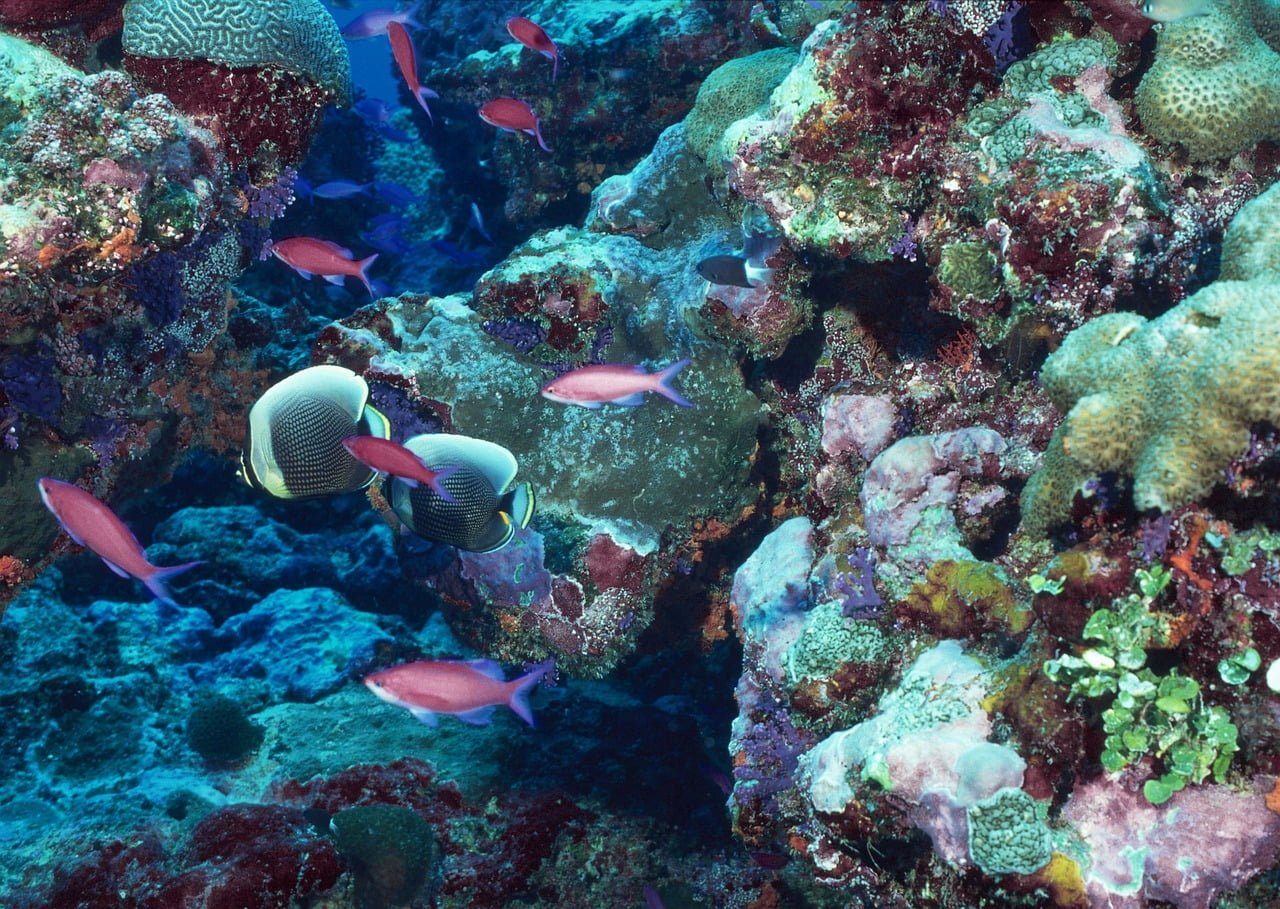Dive into the magical world of aquascaping a reef tank, where you learn to create an underwater paradise full of vibrant corals and colorful fish. This guide will help you become an expert in designing and maintaining these beautiful mini sea worlds. From history to the latest trends, you’ll discover the secrets of building a thriving reef ecosystem. Step by step, you will explore the fascinating world of corals, fish, and how to make sure they all live happily together. Get ready to turn your reef tank into a stunning masterpiece and become a true artist of the underwater realm.
Mastering the Art of Aquascaping a Reef Tank
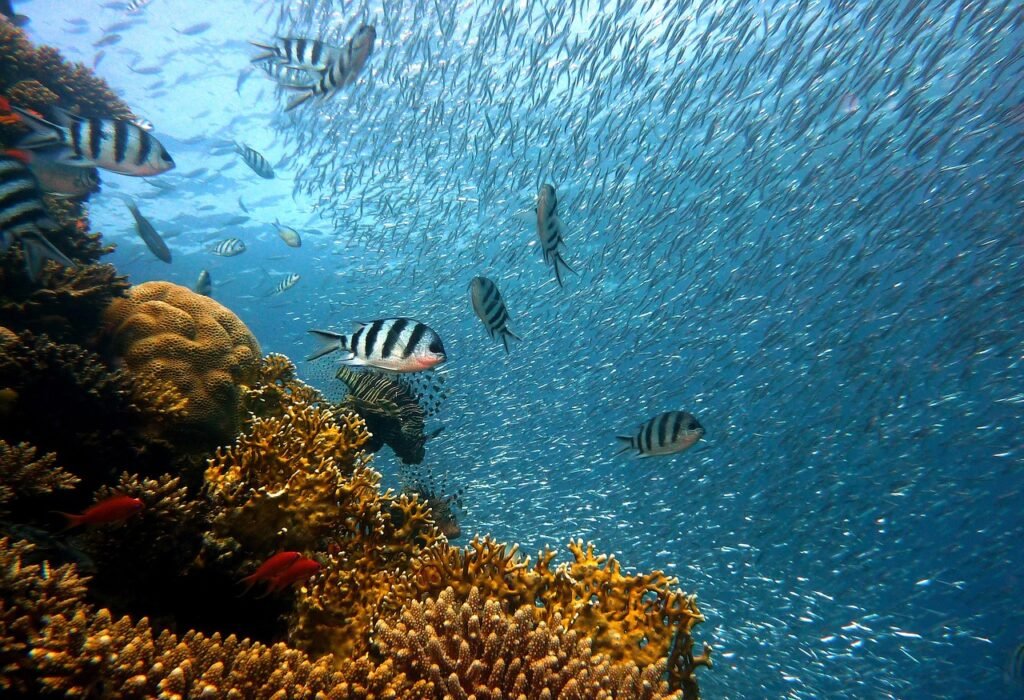
Have You Ever Wondered How to Create an Underwater World?
Imagine having a mini ocean in your home. Wouldn’t it be amazing to see colorful fish swimming around beautiful corals, right in your living room? That’s what aquascaping a reef tank is all about! In this article, we’ll teach you everything you need to know about this fascinating hobby.
What is Aquascaping?
Aquascaping is like gardening but underwater. You create beautiful landscapes inside an aquarium using plants, rocks, and other natural elements. When it comes to reef tanks, you’ll be using corals and marine creatures to build your underwater paradise.
Why is Aquascaping a Reef Tank Important?
Aquascaping is not just about making your tank look pretty. It creates a healthy environment for your fish and corals. A well-designed reef tank provides hiding spots for shy fish and mimics their natural habitat, making them feel at home.
The Magic of Coral Reefs
Coral reefs are some of the most diverse ecosystems on Earth. They provide homes for countless marine species. By creating a reef tank, you’re not only making a cool decoration but also helping to protect these fragile ecosystems by learning more about them.
A Brief History of Aquascaping
The Start of Aquascaping
Aquascaping became popular in the 1990s, thanks to a Japanese artist named Takashi Amano. He showed people how to create beautiful underwater landscapes using plants, stones, and driftwood.
The Rise of Reef Tanks
While plant-based aquascapes were the initial focus, the idea of creating reef tanks started to grow. With advancements in technology and a better understanding of marine life, more people began creating their own underwater reefs.
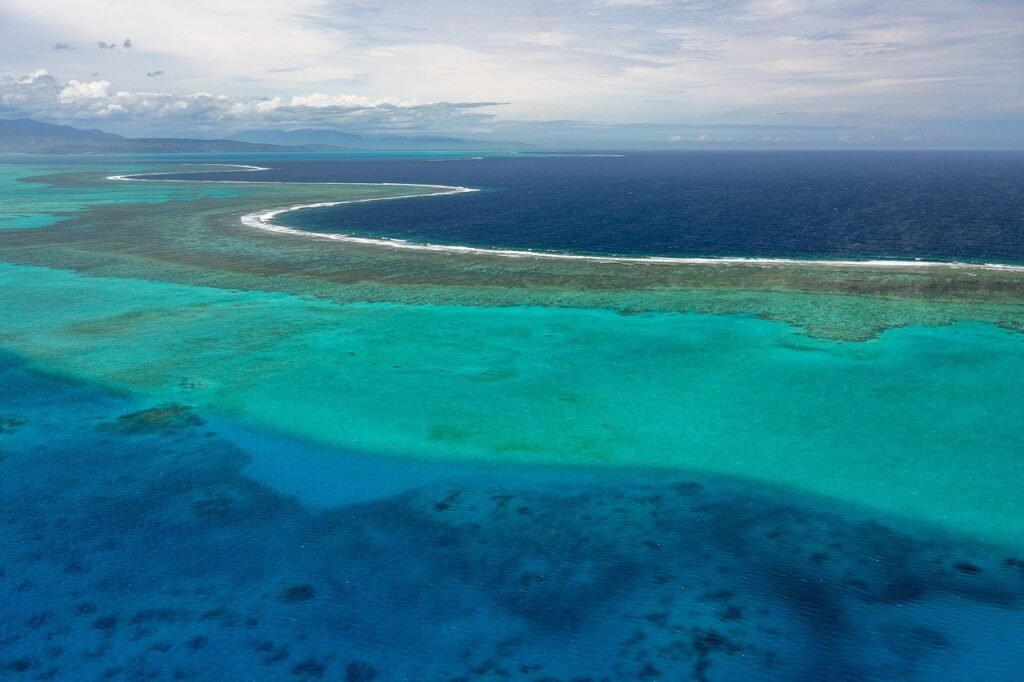
Current Trends in Aquascaping Reef Tanks
Minimalist Designs
Many people now prefer minimalist designs with fewer, but more striking, elements. This puts the focus on the beauty of the corals and fish themselves.
Sustainable Practices
There’s a big push towards sustainability, ensuring that the corals and fish used are ethically sourced. This helps protect natural reefs and ensures that the hobby doesn’t harm the environment.
Use of Technology
New technologies like LED lighting and advanced filtration systems make maintaining a reef tank easier and more efficient, allowing more hobbyists to create stunning aquascapes.
Key Concepts and Definitions
What is a Reef Tank?
A reef tank is a type of aquarium designed specifically to house corals and other marine life. Unlike a regular fish tank, a reef tank needs special equipment and conditions to keep the delicate corals alive and thriving.
Corals: The Building Blocks
Corals are living animals that form the basis of reef tanks. They can be hard or soft and come in a variety of shapes and colors. Hard corals build calcium skeletons, while soft corals are more flexible but equally beautiful.
Live Rock
Live rock is another essential element. It’s made of pieces of coral or marine skeletons that have been colonized by beneficial bacteria and other tiny organisms. Live rock helps to filter water in the tank and provides habitats for marine life.
Lighting and Filtration
Good lighting is crucial for a reef tank because corals need light to grow. Special aquarium lights mimic the natural light found in the ocean. Filtration systems keep the water clean and free from harmful substances.

Detailed Exploration of Aquascaping a Reef Tank
Now, let’s break down the process of creating your very own reef tank!
Choosing the Right Tank
First, you need to choose a suitable tank. Reef tanks come in various sizes, but a common size for beginners is a 40-gallon tank. Bigger tanks are actually easier to maintain because they offer more stable water conditions.
Setting Up the Tank
- Location: Place your tank in a stable, well-lit area, away from direct sunlight to avoid algae problems.
- Stand: Make sure your tank stand is sturdy enough to hold the weight, as water is heavy.
- Equipment: Install the necessary equipment like filters, heaters, and lights.
Adding Substrate and Live Rock
- Substrate: First, add a layer of sand or crushed coral to the bottom of the tank.
- Live Rock: Arrange the live rock in a visually pleasing manner. This will be the foundation of your aquascape.
Water and Cycling
- Fill with Saltwater: Use a salt mix to create saltwater. You can buy pre-mixed saltwater at pet stores or make your own.
- Cycling the Tank: Cycling means getting the water ready by building up beneficial bacteria. This process can take a few weeks.
Introducing Corals and Fish
- Start with Hardy Species: Begin with hardy corals and fish that can tolerate less-than-perfect conditions.
- Acclimate Slowly: When adding new inhabitants, let them slowly get used to the tank water by floating their bag in the tank and gradually mixing in tank water.
Maintaining the Reef Tank
- Regular Water Changes: Replace 10-20% of the tank water every week to keep it clean.
- Testing Water: Regularly test the water for pH, salinity, and other parameters to ensure everything is balanced.
- Feeding: Feed your fish and corals the right type and amount of food. Overfeeding can cause water quality issues.
Example 1: A Beginner’s Success Story
Jane, a beginner aquarist, started her reef tank with a standard 40-gallon setup. She carefully selected her live rock and opted for hardy corals like Green Star Polyps and Zoanthids. After a few weeks, she introduced a pair of clownfish. Despite a few initial hiccups, regular water changes and monitoring helped her create a thriving mini-reef, proving that even beginners can succeed with patience and diligence.
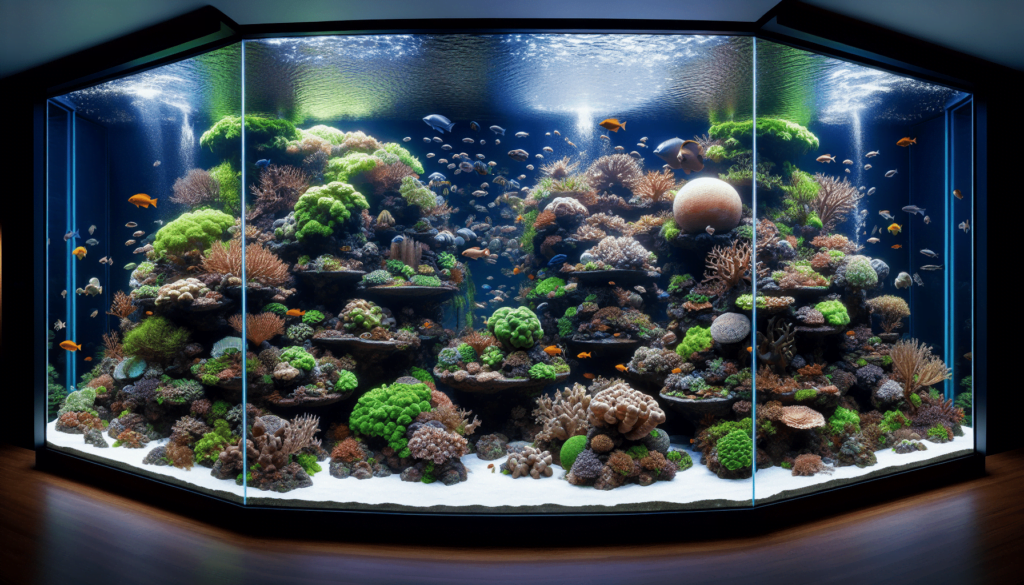
Example 2: Advanced Aquascaping Techniques
Tom, who’s well-versed in reef tanks, wanted to push the boundaries. He used a custom-built tank and incorporated advanced techniques like automatic dosing for trace elements. His choice of intricate SPS (Small Polyp Stony) corals required precise light and water conditions. Over time, Tom’s tank became a showpiece, demonstrating the possibilities for experienced hobbyists.
Comparison of Different Approaches
Natural vs. Artificial Live Rock
- Natural Live Rock: Grown in the ocean, bringing microbial diversity and authenticity.
- Artificial Live Rock: Man-made, often more sustainable, and free from unwanted pests.
| Aspect | Natural Live Rock | Artificial Live Rock |
|---|---|---|
| Biological diversity | High | Moderate |
| Sustainability | Less sustainable | Highly sustainable |
| Pest risk | Higher, may introduce unwanted species | Lower, usually pest-free |
| Cost | Generally more expensive | Generally cheaper |
Different Lighting Systems
- LED Lights: Popular for their energy efficiency and customizable spectrum.
- T5 Fluorescent Lights: Known for even light distribution.
- Metal Halide Lights: Great for deep tanks, but consume more energy.
| Lighting Type | Advantages | Disadvantages |
|---|---|---|
| LED | Energy-efficient, customizable | Initial cost can be high |
| T5 Fluorescent | Even lighting | Bulbs need regular replacement |
| Metal Halide | Excellent for deep tanks | High energy consumption, generates heat |
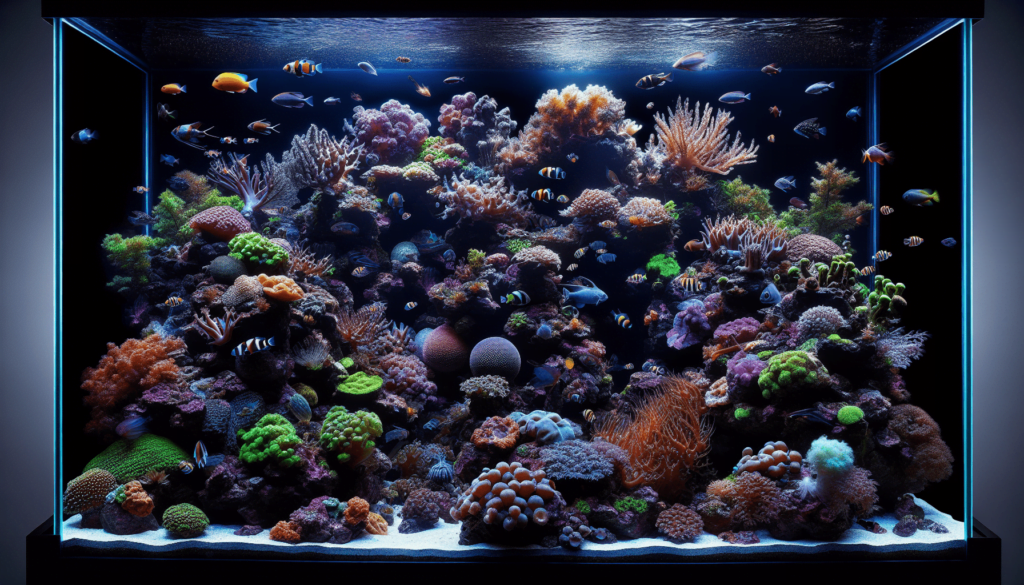
Impact Assessment of Aquascaping Techniques
Environmental Impact
Using sustainably sourced materials helps protect natural reefs. Using artificial live rock and captive-bred fish are great ways to minimize your environmental footprint.
Cost and Maintenance
Initial setup costs can be high, but maintaining a reef tank becomes more affordable over time. Proper maintenance reduces long-term expenses and ensures the well-being of tank inhabitants.
Learning and Patience
Aquascaping a reef tank requires learning and patience. The joy of seeing your underwater world flourish makes it all worthwhile. Sharing your experience can inspire others to take up this rewarding hobby.
Future Directions and Implications
Innovations in Technology
Look forward to more advancements like smart tanks that automate water changes and feeding schedules, making reef-keeping easier for everyone.
Educational Value
Reef tanks can be educational tools. Schools and museums can use them to teach kids about marine ecosystems and the importance of conservation.
Community and Sharing
Online communities and forums help aquarists share tips, troubleshoot problems, and showcase their tanks. The growing community strengthens the hobby and spreads knowledge.
Conclusion
Recap of Key Points
Creating a reef tank is a delightful mix of art and science. From choosing the right tank and setting it up, to knowing the types of lighting and rock, every step is crucial. Whether you’re a beginner or an advanced aquarist, the joy of crafting your own underwater world is unparalleled.
Final Thought
Next time you dive into a project like this, remember: you’re not just building an aquarium, you’re creating a living, thriving piece of the ocean. Isn’t that magical?
Engagement
Feel free to share your own experiences with reef tanks or ask questions in the comments. If you’re new, don’t hesitate to explore more resources and join an online community to learn more!
Credible Sources
- Sprung, J. (2006). The Reef Aquarium, Vol. 3: Science, Art, and Technology.
- Borneman, E. H. (2021). Aquarium Corals: Selection, Husbandry, and Natural History.
- Falcone, M. (2017). Reefing: A Beginner’s Guide to Reef Tanks.
- Fishkeeping World. (2022). A Comprehensive Guide to Setting Up a Reef Tank.
- Marine Conservation Institute. (2020). The Importance of Coral Reefs.
Creating and maintaining a reef tank is a rewarding experience that brings a slice of the ocean into your home. Happy aquascaping!
